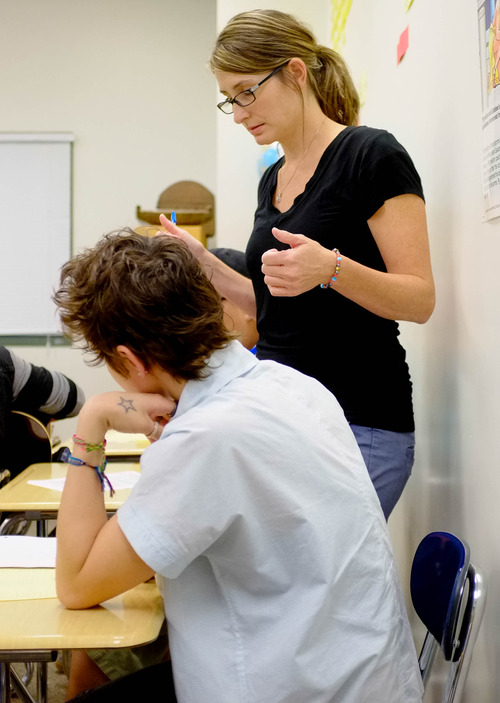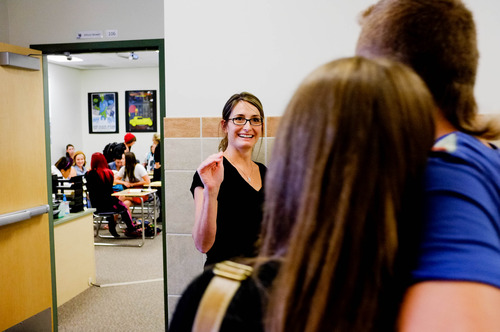This is an archived article that was published on sltrib.com in 2013, and information in the article may be outdated. It is provided only for personal research purposes and may not be reprinted.
For the first time, Utah's traditional and charter public schools have received letter grades of A through F — hailed by lawmakers as a move toward transparency and decried by educators as an unfair, one-size-fits-all ranking.
State lawmakers who passed the accountability system earlier this year — now one of two used to evaluate Utah schools — said it will improve the quality of education.
As an example, Senate President Wayne Niederhauser, R-Sandy, pointed to West High School, which received an automatic F grade because it did not have a 95 percent participation rate in testing. Regardless, he said, the school would have gotten a D grade because of its poor performance.
The Salt Lake City high school is known in part for its International Baccalaureate program for students with strong academic skills. But Niederhauser notes its graduation rate, which was 72 percent in 2012, but lower for some subgroups of minority and lower-income students.
"They're failing a huge population of their students," Niederhauser said. "...The IB program is a beautiful paint job covering up some pretty big problems."
West High School Principal Parley Jacobs emphasized that his school is a "comprehensive" high school, teaching subjects far beyond the language arts, math and science scores considered in grading. Social studies, world languages, fine arts, health/PE, advanced math such as calculus are all taught at the school, which also offers rigorous courses such as the IB program and Advanced Placement, he said.
The grades also don't take into account factors such as student engagement and school climate, he said. Jacobs said most if not all of West High students showed some academic growth. "We're not an F school, we're an A school with all we're doing with kids," Jacobs said.
∇
How grading works • School grades are calculated on a "bell curve," which means most Utah schools fall somewhere in the middle, while a few received A and F grades, said John Jesse, director of assessment and accountability at the State Office of Education.
In a letter released last week, the Utah School Boards Association, Utah School Superintendents Association and Utah Association of School Business Officials outlined their objections, compiled by Patti Harrington, executive director of Utah School Superintendents Association.
"One size does not fit all," Harrington said. "If we're all moving toward proficiency, why do we want the effect of a bell curve forcing some into failure and others into success?"
The superintendents contend the school grades will particularly harm schools that serve low-income and minority neighborhoods and undo efforts to win community support.
There are no specific consequences of the grades — no financial rewards or penalties — except the boost or blow to school reputations.
Elementary, middle and junior high schools can earn up to 600 points. Half are based on what proportion of their students are proficient in English, math and science. The other 300 points depend on the progress students make from one year to the next. The state tracks students individually from year to year, and measures their learning gains compared to their academic peers.
High schools get up to an additional 150 points from graduation rates. Starting next year, they will receive up to 150 more points based on scores from the college and career readiness ACT test, which all juniors will be able to take for free.
∇
Clarity or ideology? • Proponents such as Niederhauser said the school grades are modeled after Florida's system. In 1999, led by then newly-elected Republican Gov. Jeb Bush, Florida lawmakers passed a comprehensive set of K-12 reforms that included school grades.
Niederhauser said grades in Florida "brought a clarity and focus" to lower-performing students. Florida's student "demographics are different than ours," he said. "But we have a lot of children in our minority population that are not graduating."
Utah's statewide graduation rate in 2012 was 78 percent. The rate for white students was 82 percent, and it was 78 percent for Asian students. Among other groups:
• Hispanic and Latin American students, 63 percent.
• Black students, 61 percent
• Pacific Islander students, 73 percent
• American Indian, 61 percent
• Low-income students, 68 percent
Sen. Steve Urquhart, R-St. George, said impoverished schools will likely have worse grades, but added, "so what." He explained, "Let's shine a light. Move those gifted teachers into the lower-performing schools."
But opponents say the school grades are unfair and cause schools to needlessly be labeled as failures.
"At the time of Florida's school-grading implementation, Utah outperformed Florida in almost every indicator," the Utah superintendents' letter reads. "There is no research that connects school grading with school improvement. It remains much more of a political ideology than a research-based practice."
∇
Despite advances, an F • The superintendents also objected to treating all schools the same, such as not making allowances for the performance of students in alternative schools.
Polaris High School in the Alpine School District, for example, received an F grade. It serves 300 11th- and 12th-graders at risk of not graduating due to lack of class credits.
The alternative program allows students to earn credits faster by taking eight classes, Monday through Thursday, while Fridays consists of two additional classes and an advisory class.
Polaris opened in 2012, replacing the old East Shore High School, which had a graduation rate of 18 percent. The rate at Polaris was 62 percent. The school also has helped students earn more credits toward graduation, an increase of more than 300 percent over the previous year.
Despite those advances, the grading system ranks it as a failing school. Polaris Principal Lori Thorn said she hopes parents will not be put off by the F grade.
"My hope is that alternative schools will not be on the grading system," Thorn said. "It really is tricky."
∇
Snagging an A • The state's highest-ranked high school, the Utah County Academy of Sciences in Orem, received an A grade, earning 642 of 750 points.
It is a public, early-college STEM (science, technology, engineering and math) charter school located on the Utah Valley University campus.
Since it is a public school, officials cannot select which students can attend. Typically, about 300 9th graders apply each year for the 150 openings. Applicants are chosen randomly by lottery, as outlined by federal law.
Executive Principal Clark Baron attributes the school's success to a solid program that gives 410 students who are willing to work hard the opportunity to take college coursework in grades 10 through 12. Generally, 80 percent to 90 percent of the academy's seniors earn a UVU associate degree in University Studies a month before they graduate from high school.
"We set the bar very high and then give them the encouragement and support to meet the goal," Baron said in a statement. "Being on the UVU campus allows us to always find classes that challenge our students."
∇
What's next? • Utah already had the Utah Comprehensive Accountability System, or UCAS, in place.
Designed by the State Office of Education, it's been approved by federal officials under a waiver from No Child Left Behind requirements. The first UCAS scores were released late last year.
Despite efforts over the summer to reconcile the two systems, both remain in place.
Later this month, the state office will release UCAS results for 2013. UCAS is based on the same data — scores on Criterion-Referenced Tests (CRT) and graduation rates — plus writing assessments for some grades.
Among the differences:
• UCAS ranks schools into percentiles rather than giving them grades.
• One-third of UCAS growth points are based lower-performing students; the grading system bases half of its growth points on them.
• UCAS gives schools some points for even partial amounts of student academic growth. The grading system sets a minimum bar: schools get no points for students with growth scores that fall below the 40th percentile, when their growth is compared to their academic peers.
Lawmakers admit the new school grading system needs tweaking. Niederhauser said he supports altering the 95 percent participation rule — which is also in UCAS — so that schools with lower participation drop one letter grade, instead of receiving an automatic F.
Even so, he noted the rule affected six high schools out of more than 130 high schools that were graded.
"[Opponents of school grades] don't like the transparency and simplicity this brings out," Niederhauser said. "It's focused on student outcomes. We can't get much simpler than that. School grading is going to reveal what's under the paint." —
Find your school's grade
Go to this portal and search for the school you want. Each school receives an individual report card with scores and a grade. —































